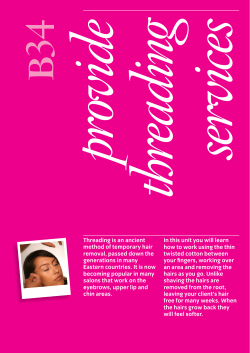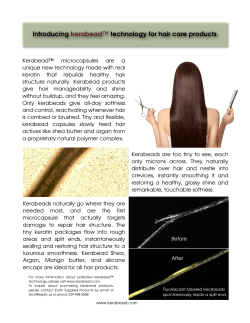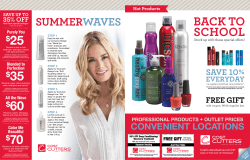
Provide threading services for hair removal
Provide threading services for hair removal UV20442 D/601/5487 Learner name: VRQ Learner number: VTCT is the specialist awarding body for the Hairdressing, Beauty Therapy, Complementary Therapy and Sport and Active Leisure sectors, with over 45 years of experience. VTCT is an awarding body regulated by national organisations including Ofqual, SQA, DCELLS and CCEA. VTCT is a registered charity investing in education and skills but also giving to good causes in the area of facial disfigurement. Statement of unit achievement By signing this statement of unit achievement you are confirming that all learning outcomes, assessment criteria and range statements have been achieved under specified conditions and that the evidence gathered is authentic. This statement of unit achievement table must be completed prior to claiming certification. Unit code Date achieved Learner signature Assessor initials IV signature (if sampled) Assessor tracking table All assessors using this Record of Assessment book must complete this table. This is required for verification purposes. Assessor name Assessor signature Assessors initials Assessor number (optional) UV20442 Provide threading services for hair removal This unit is about providing threading for hair removal on different areas of the face. To carry out this unit you will need to maintain effective health, safety and hygiene procedures throughout your work. UV20442_v7 Level 2 Credit value 4 GLH 29 Observation(s) 3 External paper(s) 0 Provide threading services for hair removal Learning outcomes On completion of this unit you will: 1. Be able to prepare for threading 2. Be able to provide threading Evidence requirements 1. Environment Evidence for this unit must be gathered in a real or realistic working environment. 2. Simulation Simulation is not allowed in this unit. 3. Observation outcomes Competent performance of ‘Observation’ outcomes must be demonstrated to your assessor on at least three occasions. 4. Range All ranges must be practically demonstrated or other forms of evidence produced to show they have been covered. 5. Knowledge outcomes There must be evidence that you possess all the knowledge and understanding listed in the ‘Knowledge’ section of this unit. This evidence may include projects, assignments, case studies, reflective accounts, oral/written questioning and/or other forms of evidence. 6. Tutor/Assessor guidance You will be guided by your tutor/assessor on how to achieve learning outcomes and ranges in this unit. All outcomes and ranges must be achieved. 7. External paper There is no external paper requirement for this unit. UV20442 3 Achieving observations and range Achieving observation outcomes Your assessor will observe your performance of practical tasks. The minimum number of observations required is indicated in the evidence requirements section of this unit. Criteria may not always naturally occur during a practical observation. In such instances you will be asked questions to demonstrate your competence in this area. Your assessor will document the criteria that have been achieved through oral questioning. Your assessor will sign off an outcome when all criteria have been competently achieved in a single client service. Achieving range The range section indicates what must be covered. Ranges should be practically demonstrated as part of an observation. Where this is not possible other forms of evidence may be produced. All ranges must be covered. Your assessor will document the portfolio reference once a range has been competently achieved. 4 UV20442 Maximum service times The following maximum service times apply to this unit: Threading (eyebrow reshape) 20 minutes Threading (upper lip) 10 minutes Threading (chin) 10 minutes Observations Outcome 1 Be able to prepare for threading You can: a. Prepare yourself, the client and work area for threading b. Use suitable consultation techniques to identify treatment objectives c. Provide clear recommendations to the client d. Select products, tools and equipment to suit client treatment needs *May be assessed through oral questioning. Observation 1 2 3 Date achieved Criteria questioned orally Portfolio reference Assessor initials Learner signature UV20442 5 © Habia Outcome 2 Be able to provide threading You can: a. Communicate and behave in a professional manner b. Follow health and safety working practices c. Position yourself and the client correctly throughout the treatment d. Use products, tools, equipment and techniques to suit client treatment needs e. Complete the treatment to the satisfaction of the client f. Record the results of the treatment g. Provide suitable aftercare advice *May be assessed through oral questioning. Observation Date achieved Criteria questioned orally Portfolio reference Assessor initials Learner signature 6 UV20442 1 2 3 Range *You must practically demonstrate that you have: Used all consultation techniques Portfolio reference Questioning Visual Manual Reference to client records Dealt with a minimum of 1 of the necessary actions Portfolio reference Encourage the client to seek medical advice Explain why the treatment cannot be carried out Modification of treatment Treated all areas Portfolio reference Eyebrows Upper lip Chin or sides of face Used all threading techniques Portfolio reference Mouth technique Neck technique Hand technique Achieved all eyebrow shapes Portfolio reference Total reshape of the brows Maintenance of original brow shape Given all types of advice Portfolio reference Avoidance of activities which may cause contra-actions Recommended time intervals between threading treatments Suitable home care products and their use *It is strongly recommended that all range items are practically demonstrated. Where this is not possible, other forms of evidence may be produced to demonstrate competence. UV20442 7 Developing knowledge Achieving knowledge outcomes You will be guided by your tutor and assessor on the evidence that needs to be produced. Your knowledge and understanding will be assessed using the assessment methods listed below: • • • • • • • • 8 Observed work Witness statements Audio-visual media Evidence of prior learning or attainment Written questions Oral questions Assignments Case studies UV20442 Where possible your assessor will integrate knowledge outcomes into practical observations through oral questioning. Knowledge Outcome 1 Be able to prepare for threading You can: Portfolio reference / Assessor initials* e. Describe workplace requirements for preparing yourself, the client and work area f. State the environmental conditions suitable for threading g. Describe different consultation techniques used to identify treatment objectives h. Describe how to select products, tools and equipment to suit client treatment needs i. Describe the contra-indications which prevent or restrict threading *Assessor initials to be inserted if orally questioned. Requirements highlighted in white are assessed in the external paper. UV20442 9 © Habia Outcome 2 Be able to provide threading You can: h. State how to communicate and behave in a professional manner i. Describe health and safety working practices j. State the importance of positioning yourself and the client correctly throughout the treatment k. State the importance of using products, tools, equipment and techniques to suit client treatment needs, skin type and conditions l. Describe how treatments can be adapted to suit client treatment needs m.State the contra-actions that may occur during and following treatments and how to respond n. State the importance of completing the treatment to the satisfaction of the client o. State the importance of completing treatment records p. State the aftercare advice that should be provided q. Describe the structure and functions of the skin r. Describe the structure and function of the hair *Assessor initials to be inserted if orally questioned. Requirements highlighted in white are assessed in the external paper. 10 UV20442 Portfolio reference / Assessor initials* Unit content This section provides guidance on the recommended knowledge and skills required to enable you to achieve each of the learning outcomes in this unit. Your tutor/assessor will ensure you have the opportunity to cover all of the unit content. Outcome 1: Be able to prepare for threading Management of health and safety at work: Clean up spillages, report slippery surfaces, remove/report obstacles, good all round access to trolleys and equipment, sterilise/disinfect tools, equipment and work surfaces, personal protective equipment. Manual handling: Moving stock, lifting, working heights, unpacking, posture, deportment, balance weight, preserve back, prevent slouching. Towels: Clean for every client, place dirty towels in covered bin. Liability insurance: Employers, public, professional indemnity. Reporting of injuries, diseases and dangerous occurrences: Accident book, reporting diseases, local bye-laws, code of conduct, risk assessment. Regulations: Control of substances hazardous to health, management of health and safety at work, manual handling, personal protective equipment, reporting of injuries, diseases and dangerous occurrences, workplace health and welfare. Hazards and risks: A hazard is something that has the potential to cause harm. A risk is the likelihood of a hazard happening. Employer responsibility: Current and valid liability insurance, display health and safety rules covering staff, employees, clients, fire evacuation, provide regular training, accurate record keeping, monitoring. Equipment: Only used for intended purpose, safe usage, handling, storage, cleaning, lifting, visual checks, worn, faulty, repairs, maintenance, portable appliance testing, correct disposal of contaminated waste, records. Reasons for risk assessment: Staff, visitors, clients, health and safety, safe environment, minimise hazards and risks, requirement of legislation. Hygiene: General – disinfect work surfaces, cover cuts and abrasions, sanitise therapist’s hands before and after treatments, clean towels between clients, place dirty towels in covered bin, dispense products with a spatula, pump or spray, use disposable towels, use disposables wherever possible, no smoking, personal hygiene, replace loose lids, uncapped bottles and pots. Disinfection – heat or chemical methods, bactericides, fungicides, viricides, UV cabinet for storage only. Disposal of waste – single use items, bin with a liner, spillages and unused chemicals, contaminated waste, hazardous waste, environmental protection. Therapist posture and deportment: Correct posture when sitting, correct posture when lifting, correct posture when carrying, working methods to avoid Repetitive Strain Injury (RSI), hand exercises, standing posture, even weight distribution, client comfort, maintain modesty, client correctly positioned to get UV20442 11 © Habia Outcome 1: Be able to prepare for threading (continued) maximum benefit from treatment, ensure therapist positioning delivers appropriate techniques, appropriate space between client and therapist, prevent injury, optimum results, allow for visual checks. Work area: Clean and hygienic, height adjustable chair, correct posture, correct couch height, lighting, ventilation, noise, music, temperature, ambience, no trailing wires, no obstructions, tools and equipment in a safe working position for therapist. Communication: Verbal – speaking manner and tone, professional, supportive, respectful, sensitive to client, open questioning related to treatment. Non-verbal – eye contact, body language, listening. Record keeping: Accurate appointment systems, stationery, loyalty, rewards, acknowledgement of occasions, consultation record keeping, contra-indications, signatures, refer to existing records, information clear and accurate, logical order, name, address, contact numbers, age range, reason for treatment, occupation, sport/hobbies, medical history, allergies/hypersensitivity, contact lenses, contra-actions, contra-indications, skin sensitivity tests, adaptations and modifications, recommendations, requirements, treatment plan, update record at the end of the treatment, update at each visit, records maintained electronically, paper records. Professional appearance: Clean professional uniform, no jewellery, no piercings, hair neatly tied back (fringe secured), closed in footwear, make-up (light day make-up), personal hygiene and 12 UV20442 cleanliness (shower/bath, cover cuts and abrasions, deodorant or antiperspirant), oral hygiene (clean teeth, fresh breath), nails (good condition and maintained). Professional ethical conduct: Polite, cheerful and friendly manner (friendly facial expressions, positive attitude, eye contact, open body language), client relations, confidentiality, respect for colleagues and competitors, avoid gossip, pride in work, punctuality, employer and client loyalty. Consultation techniques: Client requirements and therapist recommendations (client satisfaction, client expectations), aftercare (signatures of client and therapist, visual, question, listen, client card reference). Effects of the tanning product and why the result is limited (to be discussed). Benefits and effects of self tanning compared with UV tanning (to be discussed). Client preparation: Treatment options, positioning, client comfort, instruction (skin stretching), jewellery removal. Treatment objectives: Eyebrow shape – thin, medium, thick, oblique, arched, angular, straight, rounded, removal up to hairline, removal above the brow. Lip – sides or overall removal. Sides of face – chin, clarify treatment area. Recommendations to the client: Advantages, disadvantages, treatment process, hair removal areas (eyebrow, upper lip, chin, sides of face), realistic expectations, treatment plan, sensation/ pain, head position, skin stretching, Outcome 1: Be able to prepare for threading (continued) working above the brow, contra-actions, outcomes, further treatment options, aftercare advice. Products: Pre-threading lotion, after threading/soothing lotion, surgical spirits, talc, thread (medicated/non-medicated), headband, hand sanitiser, brow gel/brow powder. Tools: Mascara wand.. Equipment: Basket, bed/recliner chair, bowl, couch cover, couch roll, cotton, magnifying lamp, mirror, tissues, towel, trolley. Examples of contra-indications that may prevent treatment: Contagious skin diseases and disorders, severe skin conditions, thin or fragile skin, inflammation, swelling, sunburn. Examples of contra-indications that may restrict treatment: Moles, infected ingrowing hairs, skin tags, medication, self tan products, cuts/abrasions, eczema, hypersensitive skin, after laser treatments (skin rejuvenation, red vein), after micro‑dermabrasion, watery eyes. UV20442 13 © Habia Outcome 2: Be able to provide threading Treatment techniques (positioning of client): Lying flat/semi-reclined, couch/ recliner chair, fully supported, safe, comfortable. Treatment techniques (threading): Hand loop, neck tie, mouth threading (traditional), stretching. Treatment areas: Upper lip, chin, eyebrows, sides of face, forearm, abdomen. Skin types: Normal, oily, dry. Skin conditions: Mature, sensitive, dehydrated. Treatment adaptation: Client/therapist position, thread type, products, technique, shape, treatment area, timing. Possible contra-actions: Erythema (cold compress, soothing lotion), swelling (cold compress, soothing lotion), pain (good skin stretch, proceed or not), watery eyes (tissue), sneezing (tissue), nipping/cut (apply pressure, clean, antiseptic, avoid/ cover), blood spotting (damp cotton, change thread, correct disposal), allergic reaction (apply compress and refer to GP if necessary), ingrown hairs (gentle exfoliation 2-3 days later, moisturiser, antiseptic), breaking hair (re-thread/ tweeze). Aftercare advice: (12-24 hours) no touching/friction, no exfoliation, no make‑up/perfume products, no heat treatments (sauna, steam room, showers, facials, sun exposure, overheating), cold compress/soothing gel/lotion for calming. Skin: Epidermis – basal cell layer (stratum germinativum), prickle cell layer (stratum spinosum), granular layer (stratum 14 UV20442 granulosum), clear layer (stratum lucidum), horny layer (stratum corneum). Dermis – blood and lymph supply, fibroblasts (collagen, elastin), hair, sebaceous glands, arrector pili muscle, dermal papilla, sweat glands eccrine and apocrine, sensory nerve endings. Hypodermis – subcutaneous layer, adipose tissue, adipocytes. Functions of the skin – protection, heat regulation, absorption, secretion, elimination, sensation, formation of vitamin D, melanin production, process of keratinisation. Structure of the hair – arrector pili muscle, hair follicle, inner root sheath (Henle’s layer, Huxley’s layer, cuticle layer), outer root sheath, vitreous membrane, connective tissue sheath, root (bulb/matrix, dermal papilla), sebaceous gland, shaft (medulla, cortex, cuticle). Hair functions – insulation and protection.
© Copyright 2025
















